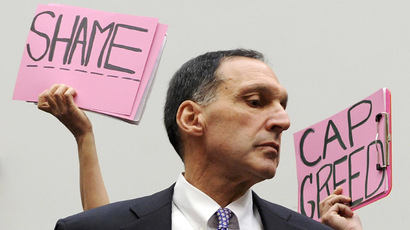'Easy money' a relief for financiers, burden for most Americans - former Fed trader
Black Friday, 2008: The Fed started pumping billions of dollars into financial markets. The benefits, however, failed to reach Main Street, instead being guzzled by Wall Street, ex-Fed exec Andrew Huszar exclusively told RT.
Huszar, at the time the Federal Reserve official responsible for the first round of the bond-buying experiment, later publicly apologized for “the greatest backdoor Wall Street bailout of all time"… "the benefits of QE have gone to the big banks,” and not to ordinary people.
“Fifty percent of Americans don’t own one stock, so how is it
trickling down?” Huszar said in an interview to RT’s Marina
Portnaya.
Quantitative easing (QE), or "easy money", is the Central Bank's unorthodox monetary program to bail out the financial sector by buying long-term government debt and lowering interest rates.
The plan sought to alleviate the pain of the crisis succeeded in saving the financial markets, but the easy money didn’t reach ordinary people. And relying on the easy money has prevented the banks from making larger structural reforms, Huszar said.
“We were bailing out the banks on some level, but the
real structural reforms that may have helped the average American
weren’t happening," Huszar told RT.
Between 2008-2010 the Fed poured $2.1 trillion to save the
indebted banks in the first round of QE, and in November 2010 it
bought $600 billion in Treasury bonds to stoke the economy. Now
in its third round (QE3), the Fed's balance sheet has amounted to
$3.7 trillion, nearly four-fold it was prior to recession.
Currently the Fed is buying $85 billion in bonds every
month.
Real economic pains
Millions of Americans lost their homes as a result of the
financial crisis, as many were mis-sold
mortgages by America’s largest banks- Bank of America, JPMorgan, and Citigroup.
“Even though we were trying to help improve mortgage lending,
make it more accessible to Americans, we actually saw a decrease
in lending in that time,” Huszar told RT.
“The problem is, the Fed at this point is the only one doing something, and it feels like it needs to continue to help. What it’s doing isn’t only helping, but maybe hurting the US economy,” Huszar said.
Before the recession, America was first in competitiveness worldwide, now it is seventh. It used to top the world’s infrastructure list, and now it has dropped to fifth place.
Quantitative easing “is an attempt to get credit back into the economy and help address some of the short term issues, where really we have long term strategic questions that need to be answered,” Huszar told RT.
But the average net worth of US families has dropped by 39
percent in just three years, from $126,400 in 2007 to $77,300 in
2010, putting living standards at the level of 1992,
according to the recent Survey of Consumer Finance by the Federal
Reserve. Meanwhile, the earnings of the median US family fell by
7.7 percent over the same period, while lower interest rates
contributed to the losses.
Forty seven million Americans are on the food stamp program.
Wall Street gains
Buying up bonds superficially increases bond prices and lowers interest rates to make stocks more appealing to investors. It has been instrumental in helping to stabilize financial markets, but the benefits have stayed on Wall Street.
The Dow Jones Industrial Average has continued its winning streak
above 16,000 points, last week the Standard & Poor's 500
Index hit 1,800 for the first time ever, and on Tuesday the
NASDAQ Composite Index rose to 4,1017,75, the highest daily close
since September 2000.
Even though they had to pay massive fines for bad-loans, in the
first half of 2013, America's financial sector posted an all-time
record high of $42.2 billion in profit, according to data by the
Federal Deposit Insurance Corp. Third quarter bank profits
dropped to $36 billion because banks had to pay off
litigation and and legal fines.














